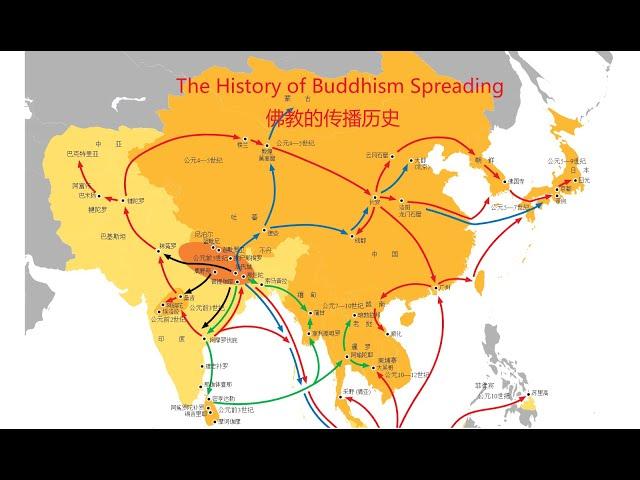
The History of Buddhism Spreading, Silk Road, Pilgrimage Journey Of Xuanzang 佛教传播,丝绸之路,玄奘之路
Buddhism was founded by Gautama Buddha in ancient India in the 6th century BC. Buddhism is the education from Buddha.
The red area is the origin place of Buddhism. It is also the Ganges River Basin in India.
Lumbini is where the Buddha was born.
Kapilavastu, Buddha’s father is the king of this country.
Bodhgay is the place where Buddha enlightened the Dharma.
Sarnath was the place where Buddha first taught Buddhism.
Kushinagara was the place where the Buddha Nirvana
Nalanda was the center of Buddhism in ancient India.
Pataliputra was the capital of the Maurya Dynasty of Magadha in ancient India.
Buddhism has three main branches, Theravada Buddhism, Mahayana Buddhism, and Vajrayana Buddhism.
One hundred years after the Buddha's Nirvana, Buddhism divided into Theravada and Mahayana.
Mahayana
Mahayana uses Sanskrit as its main language, and monastic and lay followers work for the liberation of all sentient beings, making compassion and insight (wisdom) its central doctrines.
Theravada
Theravada is the only remaining school from the Early Buddhist period. Its central texts are in Pali (Pãli Canon), the spoken language of the Buddha; and its exclusively monastic devotees strive to become enlightened for their own liberation.
Vajrayana
Vajrayana Buddhism is the late development of Mahayana Buddhism. It absorbed some theories and methods of Indian traditional Brahmanism.It includes practices that make use of mantras, dharanis, mudras, mandalas and the visualization of deities and Buddhas.
We can see the black line represents original Buddhism.
The red line represents Mahayana Buddhism
The green line represents Theravada Buddhism
The blue line represents Vajrayana Buddhism
Since the time of Ashoka, Buddhism began to spread continuously.
This route is also the Pilgrimage Journey Of Xuanzang
Chinese Buddhism continues spreads from the Central Plains to Northeast China, South Korea, Japan and Vietnam.
See this green line. Theravada Buddhism spread through Sri Lanka to Myanmar, Thailand, Laos, and Cambodia, and form Southern Buddhism area.
See this blue line. During the Tang Dynasty, Vajrayana Buddhism was introduced to Tibet and merged with Tibet native religion, Bon, to form Tibetan Buddhism.
Vajrayana Buddhism continued to spread to Mongolia and Japan, and now it is currently most prosperous in Tibet and Japan.
Before the arrival of Islam, Buddhism spread widely, including Pakistan, Afghanistan, Turkmenistan, Uzbekistan, Kazakhstan, Tajikistan, Kyrgyzstan, Xinjiang, Malaysia, and Indonesia.
Finally, let's talk about where the monks can eat meat?
Actually, except Chinese Buddhism which advocates vegetarianism, both Southern Buddhism and Tibetan Buddhism allow eating meat. Japanese Buddhism allowed monks to eat meat and get married after the Meiji Restoration.
佛教由古印度的釋迦牟尼在公元前6世紀創建。
佛是指佛陀,觉悟者。教是指教育。
佛教就是觉悟者的教育。
红色的区域是佛陀在世时,传播佛教的核心地带。这里也是印度恒河流域。
蓝毗尼是佛陀出生的地方。
迦毘羅衛城,古代釋迦族的國都,釋迦牟尼的父亲就在这里当国王。
菩提伽耶是佛陀证悟佛法的地方。
鹿野苑,今天叫瓦拉那西,是释迦牟尼第一次教授佛法的地方。
拘尸那迦,是佛陀入灭的地方
那烂陀,是古印度的佛教中心。古代印度最高的佛教学府就是再那烂陀寺。
華氏城是古印度摩揭陀国孔雀王朝的首都。
佛教,有三個主要的分支,分別自称为
上座部佛教、大乘佛教,和密乘佛教
上座部和大乘佛教的主要区别是:
在佛灭一百多年后,佛教发生根本分裂
分为上座部與大眾部
上座部佛教认为要想到达彼岸,修成佛果,主要依靠“自度”。
而大众部演变出来的大乘佛教主张佛教徒,不仅要“自度”还要度人。
密乘是大乘佛教發展到後期,吸收了印度傳統的婆羅門教的一些理論和方法,發展出密乘,也稱金剛乘。這一派認為如來所宣的「真實密意」,不可輕易示人,需秘密傳授。
回到地图,我们可以看到
黑线代表原始佛教,释迦牟尼时期的佛教
红线代表大乘佛教
绿线代表上座部佛教
蓝线代表密乘佛教
自從阿育王時期,佛教开始不斷地向外傳播,
先看这条红线,大乘佛教从印度,经过巴基斯坦健陀罗,中亚,沿着丝绸之路进入新疆楼兰,甘肃敦煌,最终传到中原长安,形成了汉传佛教,这条路线也是玄奘取经的道路。
汉传佛教,从中原再流傳到中國的东北,韓國、日本以及越南。
再看这支绿线,上座部佛教,通过斯里蘭卡,傳播到緬甸、泰國、老挝、柬埔寨。形成南传佛教。
最后看这支蓝线,唐朝時期,密乘佛教,傳入西藏,与西藏的本土宗教,苯教互相融合,形成藏传佛教。
密乘佛教继续向蒙古和日本传播,目前密教在西藏和日本最為興盛。
在伊斯兰教到来之前,佛教传播之广,包括巴基斯坦,阿富汗,土库曼斯坦,乌兹别克斯坦,哈萨克斯坦,塔吉克斯坦,吉尔吉斯斯坦,新疆,马来西亚,印度尼西亚都是一片佛音缭绕。
最后,我们来聊一下哪里的和尚可以吃肉?
其实除了汉传佛教主张吃素,南傳佛教、藏傳佛教都允许吃肉。日本佛教大多數門派在明治維新之後開放僧侶吃肉,结婚。
The red area is the origin place of Buddhism. It is also the Ganges River Basin in India.
Lumbini is where the Buddha was born.
Kapilavastu, Buddha’s father is the king of this country.
Bodhgay is the place where Buddha enlightened the Dharma.
Sarnath was the place where Buddha first taught Buddhism.
Kushinagara was the place where the Buddha Nirvana
Nalanda was the center of Buddhism in ancient India.
Pataliputra was the capital of the Maurya Dynasty of Magadha in ancient India.
Buddhism has three main branches, Theravada Buddhism, Mahayana Buddhism, and Vajrayana Buddhism.
One hundred years after the Buddha's Nirvana, Buddhism divided into Theravada and Mahayana.
Mahayana
Mahayana uses Sanskrit as its main language, and monastic and lay followers work for the liberation of all sentient beings, making compassion and insight (wisdom) its central doctrines.
Theravada
Theravada is the only remaining school from the Early Buddhist period. Its central texts are in Pali (Pãli Canon), the spoken language of the Buddha; and its exclusively monastic devotees strive to become enlightened for their own liberation.
Vajrayana
Vajrayana Buddhism is the late development of Mahayana Buddhism. It absorbed some theories and methods of Indian traditional Brahmanism.It includes practices that make use of mantras, dharanis, mudras, mandalas and the visualization of deities and Buddhas.
We can see the black line represents original Buddhism.
The red line represents Mahayana Buddhism
The green line represents Theravada Buddhism
The blue line represents Vajrayana Buddhism
Since the time of Ashoka, Buddhism began to spread continuously.
This route is also the Pilgrimage Journey Of Xuanzang
Chinese Buddhism continues spreads from the Central Plains to Northeast China, South Korea, Japan and Vietnam.
See this green line. Theravada Buddhism spread through Sri Lanka to Myanmar, Thailand, Laos, and Cambodia, and form Southern Buddhism area.
See this blue line. During the Tang Dynasty, Vajrayana Buddhism was introduced to Tibet and merged with Tibet native religion, Bon, to form Tibetan Buddhism.
Vajrayana Buddhism continued to spread to Mongolia and Japan, and now it is currently most prosperous in Tibet and Japan.
Before the arrival of Islam, Buddhism spread widely, including Pakistan, Afghanistan, Turkmenistan, Uzbekistan, Kazakhstan, Tajikistan, Kyrgyzstan, Xinjiang, Malaysia, and Indonesia.
Finally, let's talk about where the monks can eat meat?
Actually, except Chinese Buddhism which advocates vegetarianism, both Southern Buddhism and Tibetan Buddhism allow eating meat. Japanese Buddhism allowed monks to eat meat and get married after the Meiji Restoration.
佛教由古印度的釋迦牟尼在公元前6世紀創建。
佛是指佛陀,觉悟者。教是指教育。
佛教就是觉悟者的教育。
红色的区域是佛陀在世时,传播佛教的核心地带。这里也是印度恒河流域。
蓝毗尼是佛陀出生的地方。
迦毘羅衛城,古代釋迦族的國都,釋迦牟尼的父亲就在这里当国王。
菩提伽耶是佛陀证悟佛法的地方。
鹿野苑,今天叫瓦拉那西,是释迦牟尼第一次教授佛法的地方。
拘尸那迦,是佛陀入灭的地方
那烂陀,是古印度的佛教中心。古代印度最高的佛教学府就是再那烂陀寺。
華氏城是古印度摩揭陀国孔雀王朝的首都。
佛教,有三個主要的分支,分別自称为
上座部佛教、大乘佛教,和密乘佛教
上座部和大乘佛教的主要区别是:
在佛灭一百多年后,佛教发生根本分裂
分为上座部與大眾部
上座部佛教认为要想到达彼岸,修成佛果,主要依靠“自度”。
而大众部演变出来的大乘佛教主张佛教徒,不仅要“自度”还要度人。
密乘是大乘佛教發展到後期,吸收了印度傳統的婆羅門教的一些理論和方法,發展出密乘,也稱金剛乘。這一派認為如來所宣的「真實密意」,不可輕易示人,需秘密傳授。
回到地图,我们可以看到
黑线代表原始佛教,释迦牟尼时期的佛教
红线代表大乘佛教
绿线代表上座部佛教
蓝线代表密乘佛教
自從阿育王時期,佛教开始不斷地向外傳播,
先看这条红线,大乘佛教从印度,经过巴基斯坦健陀罗,中亚,沿着丝绸之路进入新疆楼兰,甘肃敦煌,最终传到中原长安,形成了汉传佛教,这条路线也是玄奘取经的道路。
汉传佛教,从中原再流傳到中國的东北,韓國、日本以及越南。
再看这支绿线,上座部佛教,通过斯里蘭卡,傳播到緬甸、泰國、老挝、柬埔寨。形成南传佛教。
最后看这支蓝线,唐朝時期,密乘佛教,傳入西藏,与西藏的本土宗教,苯教互相融合,形成藏传佛教。
密乘佛教继续向蒙古和日本传播,目前密教在西藏和日本最為興盛。
在伊斯兰教到来之前,佛教传播之广,包括巴基斯坦,阿富汗,土库曼斯坦,乌兹别克斯坦,哈萨克斯坦,塔吉克斯坦,吉尔吉斯斯坦,新疆,马来西亚,印度尼西亚都是一片佛音缭绕。
最后,我们来聊一下哪里的和尚可以吃肉?
其实除了汉传佛教主张吃素,南傳佛教、藏傳佛教都允许吃肉。日本佛教大多數門派在明治維新之後開放僧侶吃肉,结婚。
Тэги:
#Buddhism #Gautama_Buddha #Ganges #Lumbini #Bodhgay #Sarnath #Maurya_Dynasty #Magadha #Theravada #Mahayana #Vajrayana #pali #eat_meat #Tibet_Buddhism #Southern_Buddhism #Chinese_Buddhism #佛教 #释迦牟尼 #蓝毗尼 #菩提伽耶 #鹿野苑 #那烂陀 #華氏城 #摩揭陀 #孔雀王朝 #上座部佛教 #大乘佛教 #和密乘佛教 #金剛乘 #阿育王 #汉传佛教 #南传佛教 #藏传佛教 #吃素 #吃肉 #日本佛教 #Japanese_Buddhism #Loulan #Dunhuang #玄奘 #Xuanzang #西游记Комментарии:
Gaara vs Finger - Uzumaki Naruto & Sabaku no Gaara
Fiq Animation
The History of Buddhism Spreading, Silk Road, Pilgrimage Journey Of Xuanzang 佛教传播,丝绸之路,玄奘之路
湛蓝葱茏 Simple and Fun Life
REVIEW CENTERPARCS HET HEIJDERBOS 2024
Xtremerides
Center Parcs Het Heijderbos VIP-Cottage vernieuwd.
Hotel Review
Sykkuno YEETS Ranboo
Memer Clips
Tetra Pak Hoyer Frigus 600 N Ice Cream Continuous Freezer
Machinery World


























